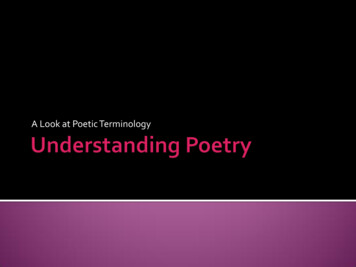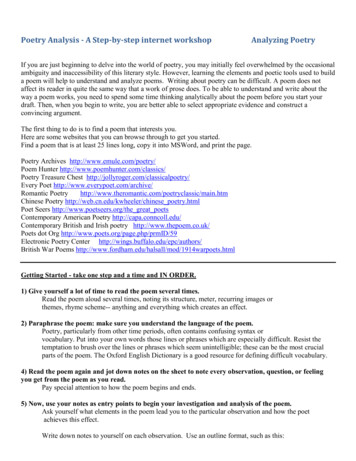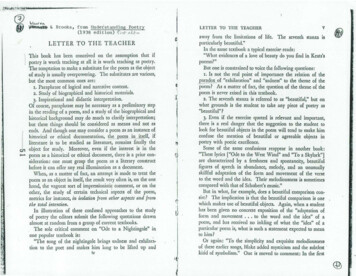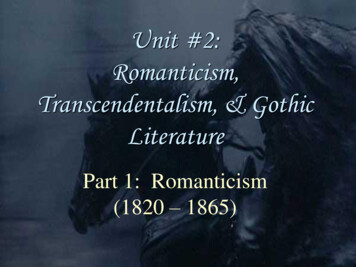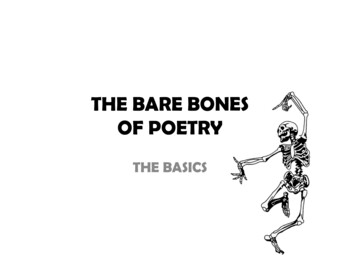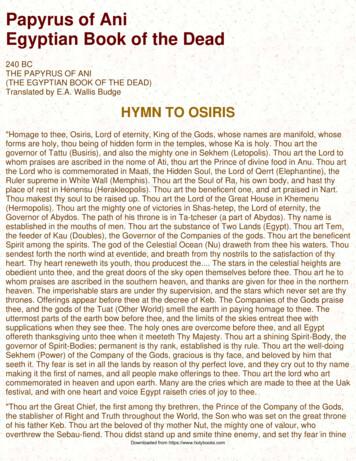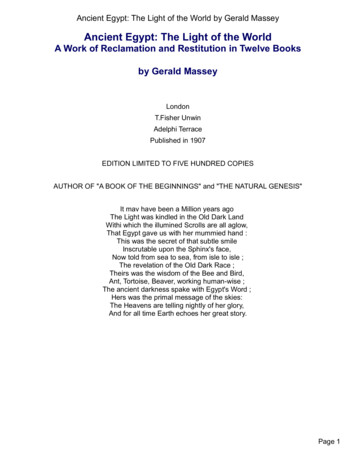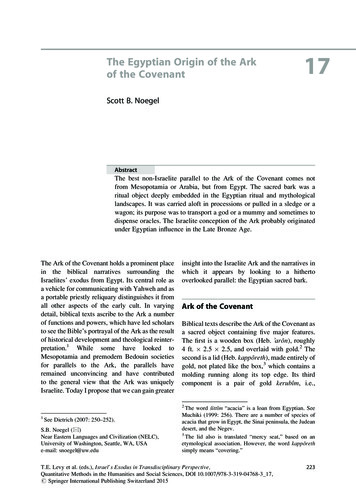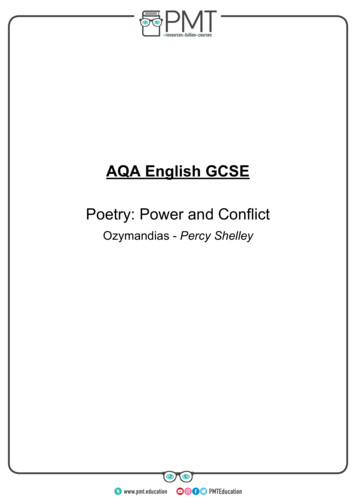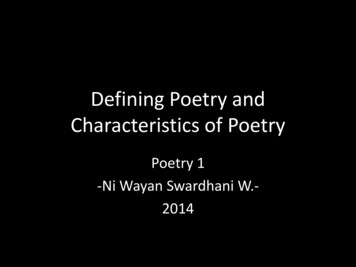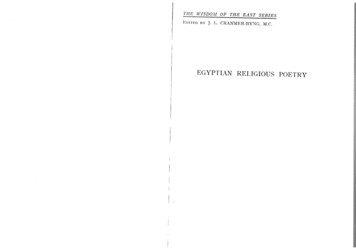
Transcription
TIlE WISDOJ'vl OF THE EAST SERIESEDITED BYJ.L. CRANMER-BY G, M.C.EGYPTIAN RELIGIOUS POETRY
EgyptianReligious PoetryByMARGARET A. MURRAY, D.Litt.fdlow of University College, LondonJohn Murray, Albem:ule Street, W.London
1TO THll MEMORY OF MY' THREE TEACHERSFirrt EditiollFLINDERS PETRIEJ.H. WALKERF. LL GRIFFITH!I:\IJlde and Printed in ern! Dril in hynu!l r & Tanner Lid., F'rome and Lon.lll/l
CONTENTSEDITORIAL NOTEPAGETHE olject Of the editor of this series is a very dtjinite one. Hedesires above all things that, ill their humble way, these books shallbe the ambassadors ( r good-will and understanding between East andWest, the old world of Thought, and the new of Action. He isconfident that a deeper knowledge of the great ideals and lofty philosophy of Orielltal thought l1Iay help to a revival of that fmc spirit ofCharity which l1either despises 110r Jcars the llatiolls of another creedand RELIGIONc.POETRY50]. L. CRANMER-DYNG.50, ALBEMARLE STREET,57LONDON,W.I.HYMNS TO Till'. SUN67IITUE PHARAOH.IIIOSIRISIVAMON79VGODS AND GODDESSESVIDEATH AND BURIAL.VII95106ONE'S NLlGIIIIOURDUTY TO GOD, TilE KING ANDII2117INDEX OF FIRST LINES6'7
PREFACEIN writing this book I am addressing those readers to whomit is the spirit of a poem that appeals, and not the exact and" scholarly" (Anglice, dull) translation. Translation is always aticklish business; on the one side there is the Scylla of the wordfor-word translation, whereby the words are given their equivalents in the other language, with often a complete loss of thespirit of the original; on the other hand, there is the Charybdisof the free translation where the translator incorporates intothe text sentiments which are not justified by the original.Translators of poetry are notoriously the worst offenders inthe latter respect, but that there are brilliant exceptions is wellknown. In these cases, however, the translators have beenpoets as well as scholars. The Psalms are a shining example ofsuch translations. In modern times, Edward Fitzgerald and SirGilbert Murray have shown that the divine fire of the originalsis not hidden when reproduced in another language. I cannotattain to such heights; all that I have attempted to do is toshow the reader that Egyptian religious poetry had in it something closely akin to our own, that to these ancient peopleGod showed himself as a God of Love as well as a God greatand terrible. Though many of the epithets applied to theDeity are strange and unfamiliar to us, they meant as much tothe Egyptian worshipper as " the Babe of Bethlehem" or " theSon of Man" mean to the Christian. I have, however, retainedas far as possible a word-for-word translation of many of theepithets. But in every way I have kept in mind the sayingof a master of translation, " Translation is an Art, not a Science."In arranging the book I have put first a Glossary of all names9
10PREFA CEand epithets which present any diHiculty. Then follow a sketchof the history of Egypt, a sketch of the religion, and a shortaccount of the poetry. The hynms, psalms, prayers, and proverbs form the main part of the book; these are divided intosections under appropriate headings, each item being placedas far as possible in chronological order in each section; andagainst each is the reference to an easily accessible publication.ABBREVIATIONS OF -The hieroglyphs on the cover represent the phrase" The \Vorship of God"; an appropriate motto for this hacologia.Breasted, Ancient Records.iludge, Book of tIll' Dead.Breasted, DcvcloplllCllt 4 Religion and '17lOtlglll.Budge, Egyptian Literatl/re.Blackman and Fainncll, Thc BueltCUIII.Breasted, History ,if El?ypt.Erman, Egyptian Literatllrc (transl. Blackman).Griffith, Tomb of Palleri.]ollmal of Egyptian Arcl1l1eology.Sethe, Die PyramidCllteaxlc. Spclccrs, TradllctiOlldes Texlcs des Pyramides.RCl'flC Arelu!ologiqllc.Spmc/t, i.e. tlte scelions of the fyramid Texts.Zcitscllrift fijI' Aegyplische SpYltc1,e.II
GLOSSAR YTHE transliteration of Egyptian names has always been a difficulty, for the Egyptian alphabet contains no vowels and hasletters for sounds which do not occur in European languages.A group of consonants, such as Nfrhtp, may be correct, but isimpossible to pronounce, therefore conventionally a short eis inserted to divide the syliables, thus Neferhetep. EarlyEgyptologists boldly transliterated some of the letters as vowelsor followed the Greek transcriptions, and so produced Thothand Amasis instead of the Egyptian Zehuti and Yohmes.Modern Egyptologists in trying to arrive at the correct pronunciation have produced terrible combinations like Djedj, orhave adopted the Greek forms of many of the names.As there is no standard transliteration available for the generalreader, I have compromised on using forms which are easilypronounced. The vowels are usually long, with the exceptionof the a in Amon (Greek, Ammon) and the short e which onlydivides syllables; the kh· is a guttural. Where the spelling ofa 11ame differs from the Egyptian I have put the other versionin brackets. I have divided the names into their syllables and,where required, have put the meanings.Anh-mes (Gr. At1tasis). "Child of the Moon-god." First kingof the xviiith dynasty. He drove the Hyksos out of Egypt.Abd:fish. A mythological fish, seen at sllnrise in the watersof the celestial Nile in frollt of the Boat of the Morning.Abydos (Eg. Abdu). The city of Osiris, where the early Pharaohswere either actually buried or where their cenotaphs wereerected.13
I4E GYP T I A NR E LI G IOU SPOE TRYAkh-en ten. "Glory of the Sun-disc." A king of the lateXVlllth dynasty. He introduced a new type of religional d rt. "He was known to his contemporaries as " thatcnnllnal ; modern writers call him "the heretic King".He moved the capital from Thebes to a place which henamed Akhet-aten, " Home of the Sun-disc"; it is nowknown as Tell el Amarna.All/ell or Amon (Gr. Ammon). "The Hidden One." Chiefgod of Tl ebes, and from the xviiith dynasty onwardswas the chief god of all Egypt. Often depicted with thehead of a ram with curved horns.Amentet. The West as the place to which the dead go.Amon-em-hat (Gr. Amettemmes). "Amon as the Chie("There were four !dngs of this name in the xiith dynasty,of wh m the tlurd was celebrated for his engineeringworks 111 the Fayum, and for building the great Labyrinthdescribed by Herodotus and Strabo.Amon-hotel' (Gr. Amenophis). "Amon is content." Therewere four kings of this name in the xviiith dynasty, ofwhom the fourth changed his name to Akh-en-aten.AIIlII-people. A generic name for Asiatics.Anubis (Eg. Ynpu). The jackal-headed god of death.Apis,, , Hapi). The .b.ul! god of Memphis. He was thehvmg soul of OSlflS and was the incarnation of theNile.Apol'his. (Eg: A -pep): The great serpent, the enemy of Re,wh ch hes .l walt to attack the Sun-boat, and is foiled byvanous dettIes and all the Sun-worshippers.'Archer !ribes. There were nine Archer Tribes (also called theN1I1e Bows) originally, but the phrase was often used toexpress all the hostile tribes on the borders of Egypt.GLOSSARYISAttj-crOlVll. The tall crown of Upper Egypt adorned withostrich feathers and ram's horns, worn by Osiris and inlate times by the King.Atell. The actual Sun-disc, as distinct from the more abstractidea of the god (Re) immanent in the Sun.Atl/lIl. The early name of the Sun-god, displaced later byRe.Bakhtl. The mountain of the sunrise. When the Boat of theMorning sailed between the sycamores of turquoise, withthe Abd-fish and the Ynt-fish playing in the water beforeit, it woke the serpent of the mountain, and the morninglight glittered on his scales.Bast (Gr. Bllbastis). The cat-headed goddess of Bubastis in theDelta. Though originally an independent deity, she wasfused with the lioness-goddess Sekhmet; the combinationshows the two aspects of Deity. Herodotus describes hertemple and her festival.Betll1ll-bird. A bird associated both with the Sun-god and withOsiris. It was a species of heron. The name is possiblythe origin of the word phoenix.Boat of the SlIfI. The Sun sailed on the celestial Nile in a boatwhich had several names; he rose in the Boat of theMorning and set in the Boat of the Evening. The boatwas also called the Boat of Millions of Years, and theNeshemt-boat, or simply the Boat. At the prow werestationed the various deities who protected the sun againsthis enemies.BHSi,,'s (Eg. Dedu; mod. Abtlsir). The sacred city of Osiris inthe North. Herodotus mentions that human sacrifice waspractised there.Bflto (Eg. Pi-Dep). The city of the cobra-goddess Wazt.Dual. In the Pyramid Texts this place was in the sky; but in
I6EGYPTIANRELIGIOUSthe Book of the Dead it is the Underworld to which allthe dead went, and through which the Sun-god passedevery night.Elephantine (Eg. Abu). A city at the first Cataract.Eunead. A group of nine deities. There were two Enneads,the Great and the Small. They were important in thePyramid Texts, but less so in later times. Their functionsare obscure, but they seem to have been the judges of thegods and of mankind. At Memphis they were emanationsor aspects of the god Ptah.Eye of Horus. In the fight between Horus and Setekh, thelatter tore out one of the eyes of Horus, but it was restoredto its place, whole and sound, by Re, the Sun-god. Theexpression had many esoteric meanings, i.e. food offerings,fire, spiritual power, the royal crown, etc.Fair of Face. Epithet for Ptah of Memphis.Field of Peace. A special part of heaven to "vhich only the godswere admitted.Field of Reeds. Another part of heaven, which was reached ina boat. In the Pyramid Texts only the king was admitted,but in the Book of the Dead it was the place to which allthe dead hoped to go.Flaming Lake. This was placed in the Duat when it had becomethe Underworld and could be used as a place of punishmentfor the wicked. As there were no volcanoes in the NileValley, nor is petroleum found there, the origin of theFlaming Lake must be sought outside Egypt; possibly illSouthern Russia.Geb. The Earth-god. To the Egyptian the earth was male,the sky female.Har-akheti. "Horus of the Horizons." A name given toboth the Sun-god and to Horus.I7GLOSSARYPOETRYHar-ded-ef "The viper of Horus is established." A sage andmagician greatly venerated.,Har-em-heb. "Horus in festival." The last king ofhthe xvmthddynasty, a successful general who. seized the trone, anmarried the heiress, after the extinction of the Tell el Amarnakings.Hat-shepsut. " Chief of Noble Women." The. great queenof the xviiith dynasty. She built the magmficent templeat Deir el Bahri.Heliopolis (Eg. YnH or Yun). Called On in the Bible. Thes:lcred city of the Sun-god."Hen-en-ni-sut (Gr. Herakleopolis; mod. Ehnaslyeh).TheChildhood of the King." One of the places where humansacrifice was practised.Herakleopolis. See Hen-en-ni-sut.Heri-hor. The first priest-king of the XXISt dynasty.Hermonthis (mod. Amlant). Sacred city of Mentu, the God ofHor'/:a l 'The dwelling-place of the Su -god from which heemerged at sunrise and entere agal at sunset.,Horizon-dwellers. Sometimes identified wlt l.the dead usuallyregarded as glorious and shining entitles. Possibly theprototypes of angels.House of Flame. A chapel in le te: ple."Thtp"ColneinpeaceorWelcome.L-em- 0 e .'.fi 1The nameof a great sage and magician who was del lee.Ipt-isut. "Enclosed of places." Name of the great temple ofKarnak.Kil. An integral part of the personality of gods and men. Itsurvived death in human beings, and the funeraryofferinO"s of food and drink were always for the Ka of B
18EGYPTIANRELIGIOUSPOETRYSo-and-so. The word has been translated in many ways,but the exact meaning is unknown.Ka-mes. "Child of the Bull." A king of whom there arefew remains. He took part in driving out the Hyksos.Khepri. "The Existent One." The self-existent god, whogives life to the dead Sun and revivifies all nature. Represented as the scarab.Kheri-aha. The traditional site of the fighting between Setekhand Horus.Lady of Life. The serpent on the king's head, emblematic ofsovereignty. Also placed on the Sun's disc.Letopolis (Eg. Sekhem). Human sacrifice was a regular part ofthe ritual at this temple.Manu. The bill of the Sunset.Maot. The goddess of Truth, Justice and Righteousness, adaughter of the Sun-god. Represented as a woman withan ostrich feather on her head. The fillet round her hairis perhaps the origin of the classical representation ofJustice with bandaged eyes. Her name occurs in thethrone-names of many Pharaohs.Menes (Nar-mer). The first historic King of Egypt. He unitedUpper and Lower Egypt and brought the whole land underone rule. He founded Memphis (Eg. Men-nefer) byturning the course of the Nile and so reclaiming muchland.Mentu (Gr. Month). The God of War.Mer-en-Ptah. "Beloved of Ptah." A king of the xixthdynasty, son of Rameses II. He drove out all the foreignerswho had settled in the Delta, among whom (if the chronology is correct) were the children of Israel.Mut. "Mother." The chief goddess of Thebes. The personification of the crown of Upper Egypt (the White Crown).GLOSSARY19Nefer-ka-Re. "Beautiful is the ka of Re." Throne name ofPepy II of the vith dynasty.Neith. The personification of the Crown of Lower Egypt(the Red Crown). Her sacred city waS Sais. Herodotusdescribes a festival of Neith.Nekheb (mod. El Kab). The "Southern Shrine" of thehymns.Nekhebt (Gr. Eileitheia). The goddess wh represented theSouth, depicted as a vulture. Her functIon was to protectthe king.Nekhen (Gr. Hieraconpolis). The capital of Upper Egypt mprehistoric times.Nephthys (Eg. Neb-het, " Lady of the house "). .Originally thegoddess who received the Pharaoh on hIS death. .Shebegan as an independent deity; later, was made. SIsterof Isis, with whom she mourned the death of Osms.Neshemt. See Boat of the Sun.Nut. The Sky-goddess. The sun was born of her every' dayand died in her arms every night. Represented as a gIgantic woman bending over the earth with her feet and handstouching the ground while her curved body makes thearch of the sky.Pepy. There were two kings of this name in the vith .dyn sty.In the pyramids of both the burial chambers a e mscnbedwith the religious texts known as the PyramId T xts.Ptah. Chief god of Memphis. God of all the arts of lIfe.Pllnt. Generic name for the trading ports down the Red Seaand possibly along the south of Arabia. The" Land ofPunt" was known as the Land of the Gods, and was celebrated for spices and perfumes.Rameses. "Child of the Sun." There were eleven kings ofthis nam , of whom the best known was R:imeses II of
20EGYPTIANRELIGIOUSPOETRYthe xixth dynasty. He was perhaps the Pharaoh of theOppression.Ramesseum. Modern name for the funerary temple of Rameses I, whIch was one of the greatest and most magnificent111 Thebes.Re or R a. T h e Sun-god. Though often acclaimed as thesupreme god, he had to be. protected from his enemies byother gods and even by Ius devoted worshippers.Re-stau. "The mouth of the Passages." A name for thetomb, especially a royal tomb.Sehepu. An unknown entity.Sekhmet. "Th Mighty One." The lioness-headed goddessof Memp Is, often fused with Bast, the cat-headed goddessof BU :stIS. She was regarded as a destroying deity.Sen-usert.Man of the Strong Goddess." There were fourki gs of this name in the xiith dynasty. The first andthird were great conquerors.Se-qenen-Re. :: He whom Re causes to be strong." A kingof the xVllth dynasty, who rebelled against the Hyksosand was killed in battle.'Setekh.-nekht. "Setekh is victorious." The last king of thexIxth dynasty.Shishak (Eg. Sheshanq). A king of the xxist dynasty, withwhom Jeroboam took refuge when he fled from Solomon.In the fifth year of Rehoboam Shishak raided Palestineand sacked the temple at Jerusalem.Shu. The god who lifted up the sky from the earth. He wasregarded as tlte god of light, and was the first creation ofthe supreme God.Sothis (Eg. Sopd). The Dog-star. The rising of the Dog-star t da.wn was the herald of the inundation. The star wasIdentIfied with Isis, and according to the legend it was theGLOSSARY21tears shed by the goddess for the loss of her husband Osiriswhich caused the inundation.Stars. The Imperishable or Never-setting stars are the circumpolar stars which were always visible in the latitude ofMemphis. The Unwearied or Never-resting stars wereprobably the planets.Ta-mery. "The cultivated Land." A name for Egypt.Tatunen. An ancient god of Memphis; afterwards fused withPtah.Tefnut. A creation-goddess, from whom and from her brotherShu all other deities were derived.Tety. A king of the vith dynasty, in whose pyramid the wallsof the burial chamber were inscribed with the PyramidTexts.Thanent. A site sacred to Osiris.Thoth (Eg. Zehuti). The god of writing, mathematics, medicine and magic, and god of the moon in its aspect asmeasurer of time. Called Hermes by the Greeks. Represented as an ibis-headed man. The dog-headed baboonwas sacred to him. His sacred city was Khemennu (Gr.Hermopolis; mod. Eshmunen).Thothmes. "Child of Thoth." There were four kings of thisname in the xviiith dynasty, of whom the third was thegreat conqueror, who founded the Empire of Egypt.Two Lands'}NCEtTwo Regiolls. ames ror gyp.Two Sisters. The goddesses Isis and Nephthys, sisters of Osiris.Utl-Herer. "The Good Being." An epithet of Osiris.Up-u ut. "The Opener of the Ways." Thc jackal god ofSiut.Wazt (Gr. Bllto). The cobra-goddess of Buto, whose oraclewas famous. Her image was the chief cmblem of royalty,
22EGYPTIANRELIGIOUSPOETRYwas worn on the brow of ever Phhorigin of the fabulous basilisk o/the ao k' and was theWenis A kif h.ree s.ng 0 t e vlth dynasty in whose.d Iewalls of the burial chamber were i scribed with hreapmI t :dTexts.yrami}'Iz-mut-e.if. "·11PI ar of his M I ".borne by the k · 'ot ler.A pnestly title, usuallymg s son.Yl1t-jish A m th 1 . 1 fi hM·.Y 0 gIca s, accompanying the Boat of theornmg at sunnse when it w. dd·'YIIU (Gr. Heliopolis).Th hi f a.s seenfm e Ies of. turquoise.e c e CIty 0 Sun-worshIp.INTRODUCTIONTHE importance of Egypt in the study of religion and in theperformance of rites and ceremonies attracted attention as earlyas the time of Herodotus, for the Greeks were always ready toacknowledge their indebtedness to the people of the Nile Valley.Herodotus puts the matter in a few words: "The Egyptians.were the fmt to discover the year, which they divided intotwelve months . . The Egyptians were the first who introduced the names of the twelve gods, and the Greeks borrowedthose names from them; they were the first to assign altars,images, and temples to the gods, and to carve figures of animalsin stone. . . The Egyptians were also the first who introducedpublic festivals, processions, and solemn supplications" (Bk. ii,4, 58).Palestine was so closely linked geographically with Egyptthat the influence of that great civilization must have beenimmense on the smaller and less civilized country. But to thejealous and barbarian Hebrews the splendour of Egypt was anoffenc;e, though they borrowed largely from the ideas and ideals,and even the very language, of the Egyptians. Yet in spite ofhatred and malice, the influence of Egypt on the religion of boththe Canaanites and Hebrews can be clearly seen, and throughthe Hebraic Scriptures that influence is found in the later religions,Christianity and Islam.-'-3
24EGYPTIANRELIGIOUSPOETRYINTRODUCTION(a) HISTORY"t:I.gIVi:2VI2900-2750 B.C.2750-2625 B.C.2625-2475 B.C.a S {'v.{2475-2160B.C.::6 .gS {o . 2I60-2000 B.C.1 ! ;::J' 2000- 788 B.C.] -go 1).c VlSt] 1)A.{XiVxxi 1090-945 B.C.xxii 945-745 B.C.xxiii!xxiV]745-663XXVVii}viii Dynastyxvii 1600-1580 B.C.x.:iii 1580-1350 B.c.{ XIX 1350-1200 B.C.XX 1200-I090 B.C.1788 1600 B.C.xvxviThe dates before this period arC'approximate only.B.C.Assyrian conquest 666xxvi 663-525 B.C.Persian conquest 525B. c.B.C.XXVii}xx iii 52 5-400 B.C.XXIX{ XXXxxxi400-378 B.C.378-342 B.C.342-332 B.C.Alexander 332-323 B.C.Ptolcmies 323-30 B.C.Romans 30 B.C.-A.D. 641Arab Conquest A.D. 64 1Th civilization of Egypt can be traced b kfIrst mhabiting of the Nile Valley b t.;c 1 as far .as thewriting there can be no knowled ' u untl tIe commg ofgeEgypt was divided' tbof the poetry. Prehistoric.III 0 a nUIll er of small princedoms cachgo;er e by Its chief In the fourth millennium B C ' theren ere Illto Egypt a foreigp pco Ie h. .ecountry and brought with thcm e e;c e: tit:;. w; ll;first historic king of all Egypt was Menes, whose other name wasNar-mer.The long history of Egypt is divided into a series of dynasties,beginning with no. I and cnding with no. 31. This was thesystem used by the Egyptian historian Manetho (circa 270 B.C.),though his reasons for the division arc not clear. It is, however,a convenient system for indicating the sequence of events andthe position in time of certain aspects of the religion and theliterature. This is peculiarly important in the present state ofarchaeological knowledge, when every new discovery of anyvalue brings in its train some alteration in the previously accepteddating by years, making one period longer or another shorter.In tracing the changes in religion dating by years is of littlevalue; the facts of real importance arc the causes and sequenceof the changes, and these are clearly indicated in the dating bythe numbered dynasties.For those, however, to whom dating by years means much,I have given above a list of the dynasties with their approximatedates, though it must be borne in mind that any date beforethe New Kingdom is still a matter of controversy.The victories of Menrs and his immediate predecessors broughtEgypt under one rule and so ensured peace within its borders.With peace established the arts flourished, and the whole levelof civilization was raised. The Old Kingdom carried on thesplendid tradition of the Proto-Dynastic period, and in therealm of Art Egypt rose to a height in architecture and sculpturewhich she never achieved again. At the end of the Old Kingdom, actually in the vith dynasty, there was a marked degeneration in the sculpture, but it was then that the religious literatureblossomed in the most remarkable manner, for up to that timea few poetical expressions and one Triumph-Song are all thathave survived of the poetry.
26EGYPTIANRELIGIOUSPOETRYT e Old Kingdom faded gently out of existence, and Egyptfell lllto the h.ands of Syrian overlords, but the change was sogradual that It appears to have taken place without battlesor bloodshed. At all times Lower Egypt, i.e. the Delta, wasalmost as closely connected with Palestine and Syria as withURper gyPt: A Syrian overlord, with a vassal king at MemphIS call1llg. hImself Pharaoh, could rule the country with ease;for MemphIs at the head of the Delta was an ideal place fromwhich o govern both Upper and Lower Egypt. But whenthe capItal was moved farther south to Herakleopolis, the Deltafell more and more under Syrian influence, and the Pharaohbeca e a m?re chieftain of a small principality. Little is knownof thIS the FIrSt Intermediate Period, for the people of the Nor hwere sa."age in comparison with the Egyptians, and the countrylapsed llltO Ignorance and barbarism.It was not until the princes of the South founded the xithdYI:asty at Thebes that Egypt began to rise from the depth intoWhIC . she had fallen. The xith dynasty showed' the way, andthe xI th dynasty emerged as one of the greatest periods ofEgyptIan hIstory. Under the powerful Pharaohs of the xiithdynasty Egypt was peaceful and prosperous. Not only wasthe sculpture of the most magnificent, but the minor arts, suchas jewellery, have never been surpassed for beauty of designand excellence of craftsmanship. Trade at this time was extensive, and Egyptian objects have been found as far afield as Maltaand so th Russia. Th? .influx of foreign ideas and foreignpeoples IS perhap the onglll of the great output of fine literature,:vhich charac.tenzes , he xiith dynasty. The poem of theMan and HIS Soul , the Triumph-song of Senusert III thestory of Sin e, he hymn to the Crowns, and many others,show EgyptIan literature at its best.At the end of this splendid period Egypt sank again intoINTRODUCTION27obscurity and ignorance, and fell an easy prey to the hordes ofbarbarian tribes known to history as the Hyksos, whom Josephusclaimed to be the Hebrews. Crushed under the heel of theinvaders, Egypt lost her art, her literature, her temples, her veryreligion, in that orgy of destruction. Nothing remains of theearlier periods but the indestructible Pyramids and any buildingsor objects already covered by the all-encroaching sand. Thedomination of the Hyksos, lasted, according to the historianManetho, for five centuries,! but modern scholars prefer toshorten the time to two hundred years. The Hyksos weremerely destructive, they had no culture of their own, and thefew remains of their occupation of Egypt are bad imitationsof Egyptian work. Except, therefore, for scarabs and othersmall objects, the Second Intermediate Period is largely blank.At about 1600 B.C. the princes of Thebes rebelled. Under afamily, which appears to have comprised all the military geniusof the age, Thebes roused the rest of the country. The Pharaoh,Seqenen-Re, was killed in battle, but his sons, Ka-mes andAah-mes, carried on the fight against the foreigners and drovethem out. This was the beginning of the xviiith dynasty,when Egypt rose to the highest peak of power and we;J.lth.Under her great warrior-kings her Empire extended from Syriain the north to Meroe in the south, and her civilizing influencewas felt throughout the Mediterranean area and the countriesof the East. Her rule over the little pugnacious principalitiesof Palestine enforced peace on that incessantly quarrelsomecountry, and with peace she brought prosperity, as excavationhas now proved. Her Pharaohs showed a wisdom and humanityin their dealings with conquered countries in marked contrastwith all other rulers of ancient times. Here was no putting1 This is the same length of time that Serbia was under the dominationof Turkey,
28EGYPTIANRELIGIOUSPOETRYof men and women and even children "to the edge of thesword" like the bloodthirsty Hebrews, no impaling of captiveslike the cruel and savage Assyrians, no enslaving of wholenations who were not "free-born" Roman citizens. Chiefswho had resisted were probably killed out of hand, prisonersof war were sent to Egypt as slaves, usually in the temples, butthere were no massacres, no long-drawn-out and horrible deaths,no general enslavement of the population. Chiefs and kingswho had submitted were left in possession, conquered districtswere put under the charge of Egyptian governors, and thegeneral population continued their ordinary lives with greatersecurity than had been their lot previously. Egypt gave to theworld an example of moderation and humanity which has fewparallels in ancient or modern history.It is to this period of the New Kingdom that the great bulkof Egyptian literature belongs. All through the xviiith andxixth dynasties the scribes were busy writing every form ofliterature, for with the spread of education more reading matterwas required. The so-called Book of the Dead is the principalsource for the religious literature of this time. The name is amodern one, and though a misnomer is a convenient title, forthe Book of the Dead is not really a book, but consists of anumber of sections (called c!rapters by modern scholars) for uscin this world and the next. Various chapters written on papyruswere often placed in tombs, but 110 complete copy of all thechapters together has ever been found. It would seem that aIllan would have his favourite chapters copied out and laidbeside him in the grave. Though the origin of the majorityof the chapters is unknown, some few can be traced back tothe Pyramid Texts. The difference in outlook between thePyramid Texts and the Book of the Dead is very marked. Intlle Pyramid Texts every" Utterance" has reference to the king,INTRODUCTION29in the Book of the Dead the reader is the only person concerned.In the Pyramid Texts the chief pronoun is " he ", in the B okof the Dead it is always" I". In the Pyramid Texts the Kmgis born of God, is equated with God, and ascends to God atdeath; in the Book of the Dead every reader has the a eprivileges. This shows a democratic tendency in tl e reh lOnquite unexpected at so early a time. The h raohs tlll retamedtheir high position as God Incarnate, b tt It IS. po sIble that themany campaigns in which they led theIr armIes III person andin which they shared the hardships and dangers as well as thevictories with their soldiers were the ultimate cause of the chang.e.In the early periods the King was more divine than human, IIIand after the xviiith dynasty he was more man than ?ocl. Thevictories of Thothmes III (xviiith dynasty) were VOICed III thegreat Triumph-song which ascribes his triumphs to God alone.This is the more remarkable, for Thothmes appears to. have.scffered no defeats, and he might well have regarded hImselfas the sole author of his victories.For more than a century Egypt maintained her hi h po It!Onand her level of civilization, keeping the peace strIctly III all.parts of her great empire. Th n came dis ster in the sh.ape ?fa religious fanatic, to whom IllS own speCIal form of worshIpwas more than the welfare of his people. Akhenaten was theruin of his country. He began his career as dcvout. orsh:pp;,rof Amon; his name was then Amon-hotel', Amon IS content .After four years he became violently opposed to the worsl JPof Amon, whose name he erased from every monumen . WIthequal violence he adopted a special form of sun-wo slllp, Theactual visible disc of the sun, the Aten, was the object that headored, not the abstract idea of divinity immanent in the S lIl,which was the esscncc of RC-worship. He moved t
I6 EGYPTIAN RELIGIOUS POETRY the Book of the Dead it is the Underworld to which all the dead went, and through which the Sun-god passed every night. Elephantine (Eg. Abu). A city at the first Cataract. Eunead. A group of nine deities. There were two Enn
